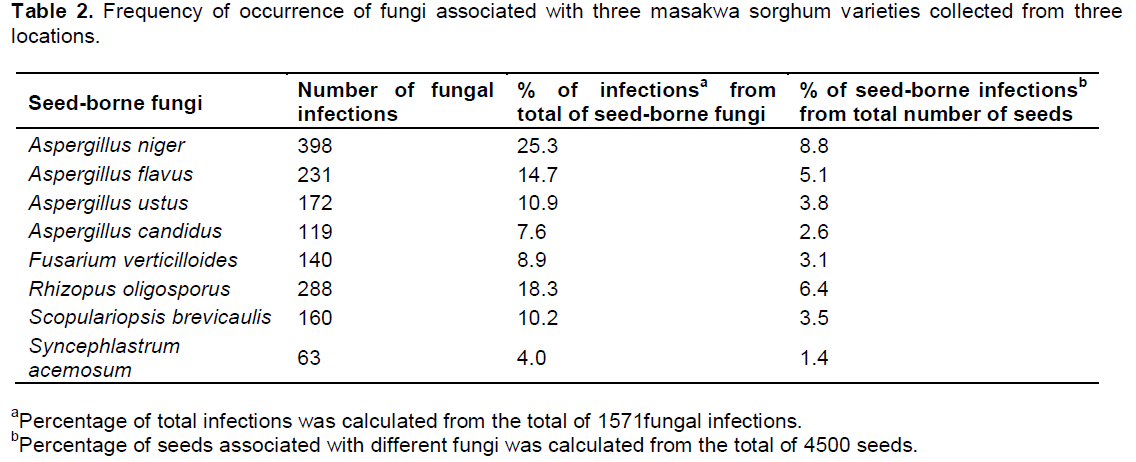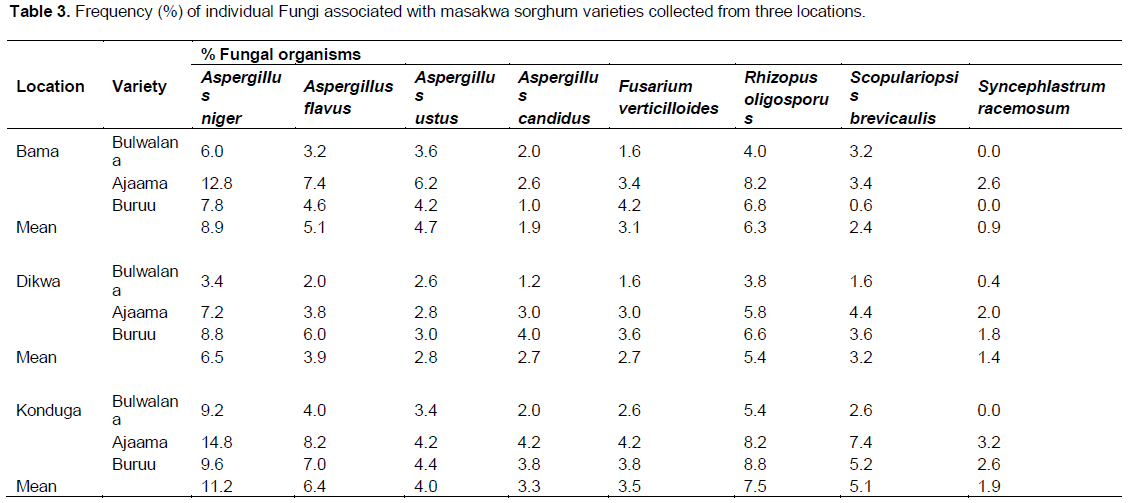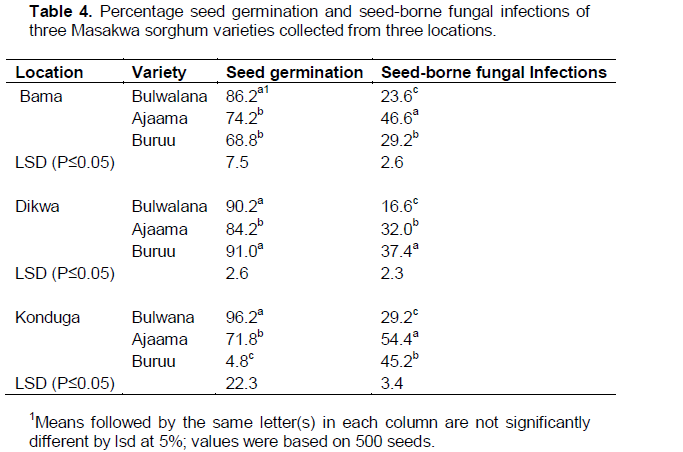ABSTRACT
A laboratory study was conducted at the Department of Crop Protection, University of Maiduguri, Nigeria to assess the incidence of seed-borne fungi and their effects on seed germination of Masakwa sorghum (Sorghum bicolor). Three varieties (Bulwana, Adjaama and Buruu) used were collected from different locations namely Bama, Dikwa and Konduga of Borno State, Nigeria. About 34.9% of the seeds were infected by different species of fungi obtained from the varieties selected from the locations. Eight different fungi identified were Aspergillus candidus, Aspergillus flavus, Aspergillus niger, Aspergillus ustus, Fusarium verticilloides, Rhizopus oligosporus, Scopulariopsis brevicaulis, and Syncephalastrum racemosum. The most predominant fungi were A. niger (25.1%), R. Oligosporus (18.3%), A. flavus (14.7%), A. ustus (10.9%) and S. Brevicaulis (10.2%). Germination and seed-borne fungal infections varied significantly (P≤0.05) with varieties and locations of seed collection. Percent germination ranged between 4.8 and 96.2%. The highest seed-borne fungal infection (54.4%) was observed on seeds of variety Adjaama collected from Konduga and lowest infection (16.6%) on variety Bulwalana from Dikwa. Generally, fungal infection had played a significant role in the reduction of percentage germination of Masakwa sorghum in all the varieties. Hence, it becomes necessary for the seeds to be treated before planting to eradicate these seed-borne pathogens because of their inherent danger.
Key words: Masakwa, sorghum, mycoflora, seed-borne, fungal frequency.
Masakwa is a local variety of transplanted sorghum (sorghum bicolour (L.) Moench) mostly cultivated in the Lake Chad Basin areas of Republic of Chad, Cameroon and Nigeria covered by heavy black soils (vertisols). In Nigeria, the crop is predominantly grown by farmers in Borno State in the extreme north-eastern part of the country. It is grown during the dry season on residual soil moisture following the main rains. In areas where the system is being practiced, the land is flooded for weeks or months during the rains. Farmers build small bunds so that water is retained and infiltrates the soil. As the flood recedes and the surface soil gets dried up, Masakwa seedlings are transplanted into the field.
Masakwa sorghum is an important economic crop in the areas where it is grown. Its utilization is much similar to those of rainfed sorghum. In addition, it provides supplementary supply of grains and forage during the dry season for both human and livestock consumption, respectively (Gworgwor, 2001). It can be cultivated extensively as cash crop to sell in urban centres (Blench, 1997).The seed can also be saved for planting the next season.
Seeds are regarded as highly effective means of disseminating plant pathogens. The presence of pathogens in seed had been responsible for poor health of seed in many crops (Neergaard, 1979), and development of diseases at later stages of plant growth (Khanzada et al., 2002; Bateman and Kwasna, 1999). Seed-borne diseases can affect the growth (Weber et al., 2001) and reduce productivity of crop plants (Williams and Rao, 1984). The presence of pathogens in seeds therefore, determines the quantity and quality of the crop being raised.
Seed-borne mycoflora of sorghum reported to be most frequent in seed samples were Phoma sorghina (Nafula, 1997), Curvularia lunata (Panchal and Dhale, 2011; Islam et al., 2009), Aspergillus flavus, Aspergillus niger, Rhizopus sp. and Penicillium sp. Fakhrunnisa and Ghaffar (2006) Aspergillus sp. (Abdulsalam and Shenge, 2011).
There is little or no information on the types of mycoflora associated with Masakwa sorghum seed in Nigeria. It is, therefore, the aim of this study to identify those fungi and determine their implications on seed germination.
The experiment was conducted in the Plant Pathology Laboratory of the Department of Crop Protection, University of Maiduguri, Nigeria. One kilogram seed of Masakwa sorghum was collected from the markets of three different locations (Bama, Dikwa and Konduga) of Borno State. Nigeria. Three local varieties of Masakwa sorghum used were Bulwalana, Ajaama and Buruu.
Blotter method
The fungi associated with Masakwa sorghum seeds were detected by Blotter method following the International Rules for Seed Testing Association (ISTA, 2001). In this method, two layers of filter paper (Whatman No. 1) were moistened with sterilized water and placed at the bottom of 9.0 cm diameter plastic Petri dishes. Five hundred seeds from each variety were taken at random and then placed on the moist filter paper in twenty Petri dishes at the rate of 25 seeds per plate. After plating, the seeds in the Petri dishes were then incubated at 22±2°C under 12/12 h alternating cycles of 12 h light and 12 h darkness NUV light and darkness for seven days. At the end of the incubation period, the seeds were examined under the stereo microscope for the presence of seed-borne fungi on the incubated seeds. Identification was confirmed by preparing slides of mycelia and /or conidia and examining under a compound microscope. The various types of fungi were identified using identification keys and cross-checked for each seed plated to identify the type of fungus growing. The fungal species present on each seed were recorded and the percentage incidence of each fungus per variety was computed.
Seed germination testing
Seeds were evaluated for germination using the Blotter Method described above. Seed germination count was recorded along with seed-borne infection of fungal pathogens after seven days of incubation on moist filter paper in the Blotter test. Germination counts were expressed as a percentage of the total number of seeds.
Seed-borne fungal infections
Table 1 showed the results of the total number of fungi (1571) found associated with Masakwa sorghum varieties (Bulwalana, Adjaama and Buruu) out of 4500 seeds collected from three different locations namely Bama, Dikwa and Konduga in Borno State, Nigeria. There were considerable variations in the total number of seed-borne infections depending on location. Adjaama variety collected from Konduga had the highest number (272) of fungi of the total number associated with the seed samples; followed by Adjaama from Bama and Buruu from Konduga with 233 and 226 fungal infections, respectively. The lowest number (83) of fungi was found associated with Bulwalana collected from Dikwa of the total amount of fungi in the whole samples. This study indicated that about 34.9% of the different Masakwa varieties were infected with different fungal species.
Frequency of occurrence of fungi identified
There were eight species of fungi belonging to five genera from the 1571 seed-borne fungal infections identified in Masakwa sorghum seeds collected from three locations (Table 2). The identified fungal species were: Aspergillus niger, Aspergilus flavus, Aspergilus ustus, Aspergilus candidus, Fusarium verticilloides, Rhizopus oligosporus, Scopuloriopsis brevicaulis and Syncephalastrum racemosum. Out of these, the most predominant fungus was A. niger (25.1%). Other fungi that occurred in order of prevalence were R. oligosporus (18.3%), A. flavus (14.7 %), A. ustus (10.9%) and S. Brevicaulis (10.2%). Each of these fungi amounted to more than 10.0% of the total seed-borne fungal infections. The occurrence of S. Racemosum was the lowest (4.0%). In respect of the percentage of seeds infected by individual fungi, 8.8% of the seeds had A. niger followed by R. Oligosporus (6.4%) and A. flavus (5.1%).


Frequency of individual seed-borne fungi
Table 3 showed the results of the frequency of seed-borne fungi individually associated with Masakwa sorghum varieties obtained from the three locations. The study indicated that prevalence of both the total and the individual infection of fungi observed in Masakwa sorghum seeds varied depending on location and seed variety. All the fungi were present in all the nine samples except S. Racemosum. The highest occurrence of A. niger (14.8%) was observed in Adjaama collected from Konduga followed by Bama, same variety (12.8%). The lowest count of the fungus was observed in Bulwalana collected from Dikwa (3.4%), followed by Bama, same variety (6.0%). The highest occurrence of A. flavus was recorded in Ajaama collected from Koduga (8.2%) followed by Bama (7.4%); the lowest occurrence of the fungus was shown in Bulwalana from Dikwa and Bama with 2.0 % and 3.2%, respectively. A. ustus was obtained in all the seed samples. The highest incidence of the fungus was recorded in Adjaama seed sample of Bama (6.2%) followed by Buruu sample of Koduga (4.4%); the lowest record of the fungus was observed in Bulwalana from Dikwa (2.6%). A. candidus and F. Verticilloides were prevalent in all the seed samples; however, their incidences did not exceed 5.0%. The highest incidence (8.8%) of R. Oligosporus was observed in Buruu Sample from Konduga; while the lowest incidence (3.8%) occurred in Bulwalana from Dikwa. S. Brevicaulis recorded maximum incidence (7.4%) in Adjaama sample from Konduga and the lowest incidence (0.6%) of the fungus was observed in Buruu from Bama. Seed samples from Bama (Bulwalana and Buruu) and Konduga (Bulwalana) were completely free from S. Racemosum. However, the highest incidence (3.2%) of the fungus was recorded in Adjaama sample from Konduga.
Germination and seed-borne fungal infections
There were variations in germination of the Masakwa sorghum varieties collected from the three locations. Germination varied significantly (P≤0.05) from 4.8 to96.2% depending on the location of seed collection (Table 4). The highest germination (96.2%) was recorded in Bulwalana variety obtained from Konduga, followed by Buruu (91.0%) from Dikwa.

While the lowest germination (4.8 %) was obtained in Buruu variety collected from Konduga, followed by 68.8% of Buruu obtained from Bama. Total seed-borne fungal infections also varied significantly (P≤0.05) depending on masakwa sorghum variety and location of collection. Highest seed-borne fungal infection was recorded in Adjaama obtained from Konduga, followed by Bama (46.6%) in the same variety. The lowest incidence (16.6%) was observed in Bulwalana collected from Dikwa, followed by Bama (23.6%) in the same variety. There was no pattern of relationship between germination and total seed-borne fungal infections. The highest germination (96.2%) was observed in Bulwalana obtained from Konduga, whereas the lowest fungal infection (16.6%) came from Bulwalana from Dikwa. Also the lowest seed germination (4.8%) was observed in Buruu from Konduga, while the highest (54.4 %) fungal infection came from Adjaama obtained from konduga. The results therefore, showed that there was no direct relationship between germination and seed-borne fungal infections in the varieties of Masakwa sorghum.
Out of the total number of 4500 seeds assessed for seed-borne fungal infections, 1571 seeds from the three varieties collected from the three different locations in Borno State, Nigeria were found to be infected by various fungi. The study showed that 34.9% of the different Masakwa sorghum seeds were infected. Karim (2005) and Islam et al. (2009) reported that 39% and 36% of sorghum seeds obtained from four and eight different locations, respectively were infected by fungi.
Eight fungi were found associated with the three varieties of Masakwa sorghum of which about 50% constituted Aspergillus spp. Fakhrunnisa and Ghaffar (2006) reported that 36.2% of sorghum seed samples tested to be infected with the fungi while Karim (2005) and Islam et al. (2009) reported less than 15% of these fungal species from their sorghum samples. Abdulsalaam and Shenge (2011) also found Aspergillus spp. to be the most abundant in all sorghum seed samples tested. They were, amongst other fungi, the most devastating fungi in seed germination trials in India (Randhawa et al., 1998).

The results of the present study showed that no variety of the Masakwa sorghum from all the locations was free from the fungal pathogens. They were all associated with more than one of the identified pathogens. Panchal and Dhale (2011) similarly reported that none of the seeds of sorghum varieties were found to be free from fungi, that irrespective of the environmental conditions and varieties fungi developed contact with seed either superficially, semi-deep, or completely inside the seed. These results corroborate those of Abdulsalaam and Shenge (2011) who reported the occurrence of fungi in all the sorghum seed samples tested, with less occurrence in washed than in the unwashed samples suggesting only surface contamination by some of the fungi.
The prevalence of total as well as individual infection of fungi observed in Masakwa sorghum varieties in the present study varied depending on location of seed collection. Similar differences in the frequency of seed-borne fungi of sorghum with respect to location have been reported in the crop by Islam et al. (2009) and Karim (2005). Both seed germination and total seed-borne fungal infection varied significantly (P≤0.05) depending on Masakwa sorghum variety and location of collection. Seed germinations recorded in all the Masakwa samples were always higher than the total seed-borne fungal infections except in one variety (Buruu) collected from Konduga. But no direct relationship occurred between seed germination and total seed-borne fungal infections. As the highest in percentage germination was not always the lowest in percentage seed-borne infections and vice versa. The present findings are similar to reports by Islam et al. (2009) that the highest or the lowest germination failure was not related with the highest or the lowest incidence of seed-borne fungal infections.
The occurrence of total population of fungal infections and the individual fungi detected in Masakwa sorghum seeds varied significantly (P≤0.05) with varieties as well as location of seed collection. Germination recorded in seeds obtained from different varieties and locations varied significantly (P≤0.05) from 4.8 to 96.2%. Also fungal infections varied significantly (P≤0.05) from 16.6 to 54.4%. Generally, fungal infections had significant effect on the reduction of percentage seed germination of Masakwa sorghum varieties under study. Hence, it becomes necessary for the seeds to be treated before planting to eradicate these seed-borne pathogens because of their inherent danger.
The authors have not declared any conflict of interest.
We are thankful to Mr J. N. Bitrus and J. Andrew for provision of laboratory materials and their technical assistance.
REFERENCES
|
Abdulsalaam S, Shenge KC (2011). Seed-borne pathogens on farmer-saved sorghum (Sorghum bicolour L.) seeds. J. Stored Prod. Postharvest Res. 2(2):24-28.
|
|
|
Bateman GL, Kwasna H (1999). Effects of number of winter wheat crops grown successively on fungal communities on wheat roots. Appl. Soil Ecol. 13:271- 282.
Crossref
|
|
|
|
|
Blench RM (1997). A history of agriculture in northeastern Nigeria. In . Dognin, R. And Graffenried, C. Von (Eds). L'Homme et le milieu végétal dans le Bassin du lac Tchad, pp. 69-112. Paris: ORSTOM.
|
|
|
|
|
Fakhrunnisa HMH, Ghaffar A (2006). Seed-borne mycoflora of wheat, sorghum and barley. Pak. J. Bot. 38(1):185-192.
|
|
|
|
|
Gworgwor NA (2001). Masakwa sorghum production in Borno State of Nigeria: A survey. Noma, pp. 8-19.
|
|
|
|
|
Islam SMM, Masum MMI, Fakir GA (2009). Prevalence of seed-borne fungi in sorghum of different locations of Bangladesh. Sci. Res. Essay 4(3):175-179.
|
|
|
|
|
ISTA (International Seed Testing Association (2001). International Rules for Seed Testing. Rules Amendments. Seed Sci. Technol. 29:1-127.
|
|
|
|
|
Karim M (2005). Prevalence of fungi associated with seeds of some minor cereals. M. Sc. Thesis. Department of Plant Pathology. Bangladesh Agricultural University, Mymensingh. P. 97.
|
|
|
|
Khanzada KA, Rajput MA, Shah GS, Lodhi AM, Mehboob F (2002). Effect of seed dressing fungicides for the control of seed-borne mycoflora of wheat. Asian J. Plant. Sci. 1(4):441-444.
Crossref
|
|
|
|
|
Nafula MM (1997). Assessment of seed-borne pathogens for some important crops in western Kenya. DANIDA, Denmark DGISP, pp. 747-753.
|
|
|
|
|
Neergaard P (1979). Seed Pathology. Vol. 1. Macmillan Press Ltd. P. 839.
|
|
|
|
|
Panchal VH, Dhale DA (2011). Isolation of seed-borne fungi of sorghum (Sorghum vulgare pers.). J. Phytol. 3(2):45-48.
|
|
|
|
|
Randhawa MA, Rasool G, Anwar MJ, Sahi ST (1998). Fungi associated with sorghum seed and their control. Pak. J. Phytopathol. 10(2):59-61.
|
|
|
|
Weber R, Hynezuk B, Runowska-Hynezuk B, Kita W (2001). Influence of the mode of tillage on diseases of Culm base in some winter wheat varieties, oats and spring wheat. J. Phytopathol. 149:185-188.
Crossref
|
|
|
|
Williams RJ, Rao KN (1984). A review of sorghum grain moulds. Trop. Pest Manage. 27:200-211.
Crossref
|
|



